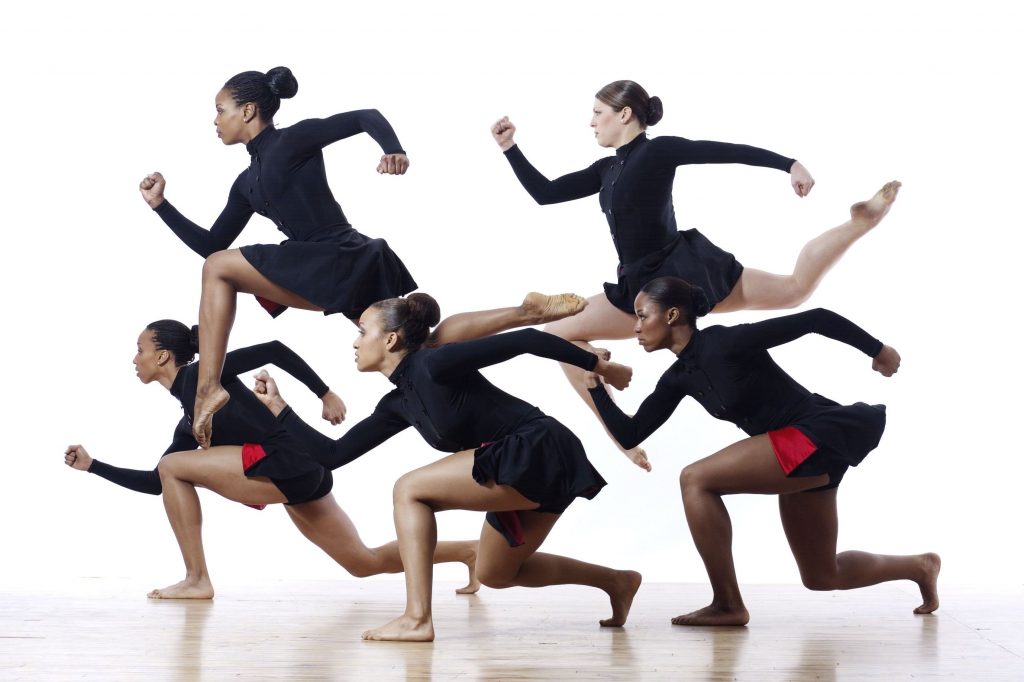
With unabashed energy and brazen athleticism, The Philadelphia Dance Company, better known as Philadanco, launched the popular and highly respected Duncan Theatre’s Dance Series at Palm Beach State College in Lake Worth on Friday night.
Presenting four works by four choreographers that drew upon African-American culture, classical ballet, and modern/contemporary dance, the passion and skill of the company’s dancers as well as their unflagging stamina awed the Duncan’s sophisticated dance audience.
The program opened with Latched by Christopher L. Huggins, which used latching on to another’s body to illustrate the connection one can have to another person’s soul or spirit. Starting immediately off in high rev, the continual attaching and detaching between three couples was interspersed with extremely physical and fast-paced unison movement performed side by side by both the men and the women.
Choreographed to the electronic music of Sohn (Christopher Taylor, an English musician), Latched was the least satisfying work presented that evening. As the opener of the program (although it was proficiently danced), it just was not enough. We needed to settle in and take it all in, but it was over before that could happen. Nonetheless, we did get a glimpse of what was in store for us. Right from the start, one could tell there was something special happening onstage with the dancers.
After a quick costume change, the six dancers from Latched returned and four more joined in to perform Between the Lines, a neatly structured work by Francisco Gella, a former Philadanco dancer who is now an up-and-coming choreographer.
Nick Kolin’s stark lighting design of shafts of light and projected rectangular patterns on the floor added a strong visual component to the confluence of movement that blended modern/contemporary dance with classical ballet to the minimalist swirling music of Philip Glass. The simple, black, non-costume costumes (together with the lighting) gave a neutral elegance to the work that allowed the viewers’ focus to be directed and fully see the intricate lyrical movement rippling through the dancers’ torsos and extremities.
The dancers never stopped their rapid and fluid movements as they met to partner in duets and a trio, or to create large formations, but there was something more happening. At the very core of this group of energized and passionate dancers, there was a clear sense of shared commitment and caring towards the work they were performing, which, in turn, created a unique cohesion in their ensemble work. I don’t mean that their arms and feet were always in perfect unison (which they weren’t), but that their intent and purpose had unity and their entire bodies responded to the movement with the same rich expressiveness.
Between the Lines was inspired by the architectural drawings of architect Frank Lloyd Wright, who listened to the music of Beethoven to find his inspiration. Finding this a little abstruse after viewing the piece, I responded better to the dancer who, in the after-performance discussion, said that Gella, when he returned to the company to create Between the Lines, credited his inspiration for the movement to the many memories and the wide breadth of his experience he had as a Philadanco company member.
This “what goes around comes around” karma is the life work of Joan Myers Brown and is the essence of Philandanco, the company she founded 47 years ago to provide opportunities for the well-trained black dancers graduating from her dance school that were not finding professional positions in the segregated dance world.
An elegant and gracious woman with a multitude of accomplishments and honors, Brown, at 85, is still the very active artistic and executive director of the company. When asked in the after-performance discussion how she makes her decision on which dancers to accept into the company, Brown simply said “I look for magic.”
The most sociopolitical work on the program was A Movement for 5, by Dawn Marie Brazemore (also a former Philadanco dancer). This powerful work drew upon the story of the so-called “Central Park 5,” five young black men falsely accused of raping a white woman jogging in New York’s Central Park in 1989. Brazemore’s bold work acutely focused on the injustice that occurred and its deep repercussions. She distilled the volatile journey of the raw emotions into an expressive work that not only captured that era but transcends and can address today’s troubled times with potent relevancy.
Under a downward-directed, interrogation-like light in the middle section of the work, Jah’meek D. Williams performed a riveting solo flanked by the other four men who lay still on their sides, wrists bound behind their bare backs. In his moving depiction of fury and frustration, Williams’ astonishing physical power was poignantly contrasted with the powerlessness and stillness of the four bound men on the floor.
As the evening progressed, there were audible gasps and wows that escaped from the audience as the same dancers kept returning moments later to dance with inexhaustible energy and steadfast integrity in the next piece of very demanding choreography.
Closing the program was Super 8!, a high-energy piece by Ray Mercer (cast member in The Lion King) which was choreographed to music by Bongi Duma and John Powell. Using a compilation of everyday experiences that touched on the bonds between couples, brothers and community, Mercer created a pleasing work that capitalized on the talents of dancers and served as a good closer to the program.